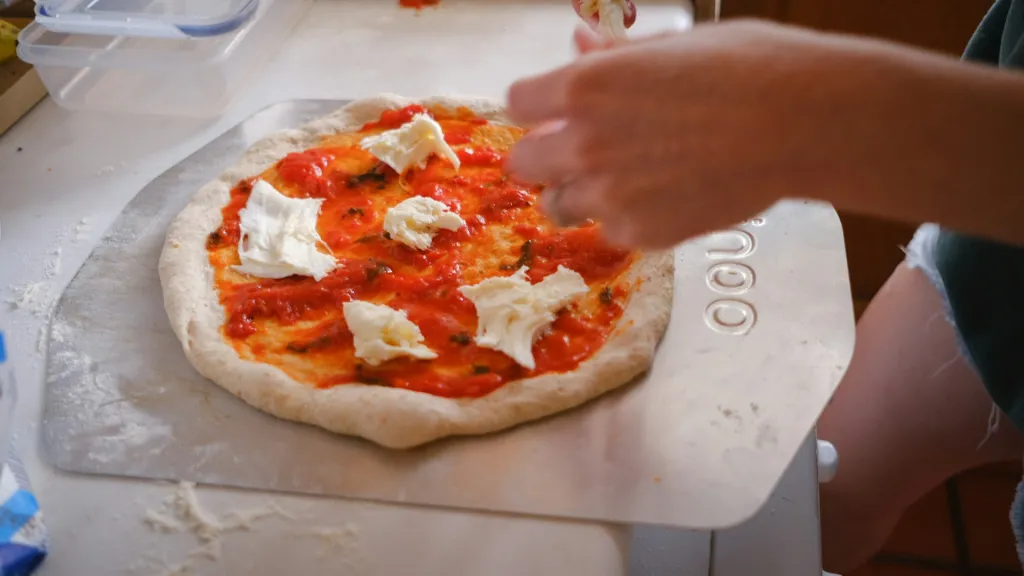
Using a Peel
A pizza peel is a flat, thin board that has a long handle. It is like a large, flat paddle. It is designed to allow you to move your topped pizza from your preparation area to your oven. The easiest way to use a pizza peel is to actually construct your pizza on the peel. First, dust the peel surface with some cornmeal. This prevents the pizza from sticking to the peel and allows it to move easily off the peel. The cornmeal acts like small ball-bearings, allowing the pizza to slide freely. Be sure to use enough cornmeal to help prevent sticking. If your pizza does end up sticking, you can loosen it with a large, flat knife or simply use a long piece of dental floss. Slide the dental floss between the bottom of your pizza crust dough and the peel and it should loosen it right up.
How do you get the pizza from the peel to your pizza stone in your oven? Well, it is simple. Place your peel with the pizza on top of it directly over your pizza stone. Tip the back edge of the peel downward until the pizza begins to slide off the peel. If you have it positioned correctly, the far edge of your pizza will slide onto the far edge of the pizza stone. Slowly move the peel out towards you, and the pizza will slide into place onto the stone. It only takes a little bit of practice to get it right every time.
When your pizza is done and ready to come out of the oven, slide the peel under the pizza with a quick sliding motion and simply pull the pizza out of the oven.
Wood vs. Metal Pizza Peels
When it comes to choosing a pizza peel, the debate often boils down to wood versus metal—each with its own strengths and quirks. Wooden peels, typically made from hardwood like birch or bamboo, are the traditional choice, favored for their natural, non-stick surface that makes raw dough slide off effortlessly into the oven. They’re sturdy, feel rustic in hand, and often double as a stylish serving board, though they can be heavier and require more care to prevent warping or cracking.
Metal peels, usually crafted from aluminum or stainless steel, shine when it comes to retrieving a baked pizza, thanks to their thin, slick edges that glide under crusts with ease. They’re lightweight, durable, and easy to clean, but raw dough can stick if not well-floured, making them less ideal for launching.
Ultimately, your pick depends on your priorities—wood for launching and charm, metal for retrieval and convenience—or you might even grab both to cover all your pizza-making bases!
Even though I would highly recommend getting a pizza peel, I can understand if you don’t have one (after all, they are a bit tricky to store, considering their size and shape). But have no fear, you can still use your pizza stone easily. Simply assemble your pizza on a piece of flour dusted parchment paper. When you are ready to bake your pizza, simply place the whole sheet (with the pizza on top) onto the stone. After a couple of minutes, the crust has set enough for you to lift an edge of the pizza and slide the paper out of the oven. Then let the pizza continue to cook until it is done.
Metal Pizza Peels
-
Pizza Peel Aluminum Pizza Spatula, Mooues 12 inch Metal Pizza Paddle with Rocker...
-
Chef Pomodoro Aluminum Metal Pizza Peel with Foldable Wood Handle for Easy Stora...
-
American Metalcraft 3016 Extra large blade pizza peel, 30-Inch
-
OUII Aluminum Pizza Peel 12''x14'' Metal Pizza Spatula Long ...
-
KLYRO Pizza Peel Aluminum Pizza Spatula Set, 12 x 14 Inch Metal Pizza Paddle wit...
-
Hans Grill Pizza Peel PRO | Made for XL Pizza 14 inch + | Professional Restauran...
-
New Star Foodservice 50196 Aluminum Pizza Peel, Wooden Handle, 16 x 18 inch Blad...
-
neatNuseful Pizza Peel 12 inch with Long Foldable Handle – Aluminum Pizza Paddle...
-
Checkered Chef Pizza Peel Extra Large Pizza Paddle Stainless Steel With Folding ...
-
Ritual Life Large Metal Pizza Peel - Pizza Peel for Oven with Folding Handle - N...
Wood Pizza Peels
-
New Star Foodservice 50295 Restaurant-Grade Wooden Pizza Peel, 16" L x 14&q...
-
Pizza Peel 12 inch, JIAFUEO Bamboo Pizza Turning Peel Wooden Pizza Paddle Spatul...
-
ALLWINNER Pizza Peel Bamboo 12 inch - Food Grade Premium Bamboo Pizza Spatula Pa...
-
TOSCANA - a Picnic Time Brand Acacia Wood Pizza Peel
-
Loftern Wooden Pizza Peel 16 Inch Board with Engraved Sizes - Multi-Purpose Bamb...
-
NUTUNI 2 Pack Wooden Pizza Peel, 12 inch Premium Large Pizza Paddle Cutting Boar...
-
Ironwood Gourmet Napoli Pizza Peel, Acacia Wood
-
Menesia 12 Inch Premium Bamboo Pizza Peel with Handle,Wooden Pizza Paddle,Cuttin...
-
Ooni 12” Bamboo Pizza Peel – Lightweight Smooth Wooden Pizza Paddle and Serving ...
-
Mooues Pizza Peel 12 Inch, Natural Bamboo Pizza Peel Pizza Paddle Spatula Oven A...

![Pizza Peel Aluminum Pizza Spatula, Mooues 12 inch Metal Pizza Paddle with Rocker Cutter Foldable Wood Handle, [Storage bag included], for Family Pizza Oven Baking Pizza, Dough, Bread & Pastry 12"x 14" Pizza Peel Aluminum Pizza Spatula, Mooues 12 inch Metal Pizza Paddle with Rocker Cutter Foldable Wood Handle, [Storage bag included], for Family Pizza Oven Baking Pizza, Dough, Bread & Pastry 12"x 14"](https://m.media-amazon.com/images/I/41ED4zwN87L._SL500_.jpg)


















